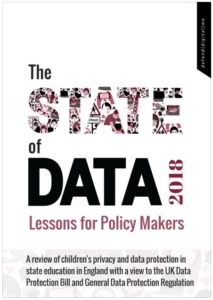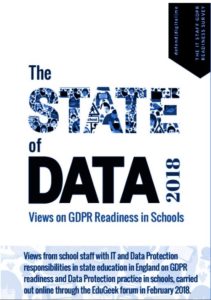The State of Data 2018:
Rights and responsibilities in education
1. The Parents’ survey of Pupil data use
The State of Data 2018 survey was carried out online, between 17th and 20th February 2018. Survation polled 1,004 parents’ opinions of children’s data collection and uses of everyday technology in state education in England. Respondents were parents of state-educated children age 5-18 in England. They were asked detailed questions about their child’s personal data in school, their understanding of which technologies were used, as well as questions about their attitudes towards the use of children’s personal confidential data at national level by third parties.
Blog A survey of parents in England has found that only half of parents agree they have enough control of their child’s digital footprint. [read more]
Highlights Infographic [download .pdf 3.4 Mb]
Full tables can be found here.
2. Event
The State of Data 2018: Rights and Responsibilities
Monday March 12, The House of Commons, Committee Room 10 [View blog with 7 recommendations for policy makers, and full event transcript]
3. State of Data 2018 Report with Lessons for Policy Makers (May 2018) v2.1
This interim report is a summary of highlights with recommendations for policy makers. It includes how parents in England think their children’s data are used in education and their attitudes and trust in some of the uses children’s data are put to at national level.
We asked parents of children in state education age 5-18 whether or not their child had been signed up to or involved with a range of everyday technologies in use in the UK education sector. We also highlight some of the key issues in some of these common technology used in schools and national pupil data collection in a cross UK comparison. With recommendations for review in key activities, and advocacy for better policy and practice.
Read as an online magazine [link]
Download small, low resolution [2.5 MB]
Download large, high resolution [17.2 MB]

4. A sample of Views on GDPR Readiness in Schools
As part of work for The State of Data 2018 we also asked school IT staff to participate.
We also ran a small and an informal survey of IT professionals from 35 schools in parallel: “Are we ready for GDPR? A survey to complete only with reference to a state-funded educational organisation for any children age 2-19 in the UK. (The word “school” in questions, refers to any such organisation delivering education).”
Download survey views from schools on GDPR readiness [snapshot of small sample of IT and Data Protection staff in 35 schools .pdf 939 kB]

5. The Full Report [Published October 2020]
The State of Data Report maps a child’s digital footprint in the state education landscape in England today, and presents an overview of key issues in children’s data collections and uses from age 2-19. Who knows what about me, and where do my data go?

6. What’s next?
Using a foresight approach, the potential impacts of the datafication of children in key areas (democratic, economic, social, and flourishing) could be explored with assessment of the drivers that will shape these outcomes. Outcomes for children are already subject to Behavioural Insights and predictive analytics on a scale well beyond that we are aware of. Where is the ethics of ‘nudge’ in national policy and in children and young people’s lives?
Having mapped these possible ‘futures’ research could examine how different policy approaches might influence these outcomes, specifically to enhance the positive impacts of the ever-growing use of personal data from children in education, while mitigating the most important risks.
Every step and path in national education policy must be based on data which are safe, fair and transparent, with the best interests of the child and human rights at their heart.